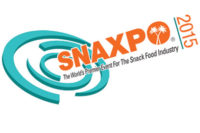Offered At SNAXPO
Snack food companies were advised to pay close attention to developments at the state and federal levels regarding nutritional policy, as they could affect snack sales in schools or possible restrictions on ads aimed at children.
A panel of nutrition experts outlined public policy developments regarding nutrition and possible laws and regulations during a SNAXPO briefing March 21.
Panel participants included Lisa Katic, K Consulting, a registered dietitian who is a consultant to SFA; Susan Borra, executive vice president, International Food Information Council; and Kari Hecker, corporate nutritionist, Frito-Lay, Inc.
Katic pointed out that the Food and Drug Administration and the Federal Trade Commission are both considering some form of regulations, that several state legislatures are considering restrictive bills, and that some members of Congress are getting in on the act.
Energy Market Overview
SNAXPO attendees were given a detailed picture March 21 of developments that affect natural gas supply and prices.
Paul Vinson, utilities manager at Printpack, Inc., traced the volatile pricing pattern that has plagued natural gas users over the past year, a condition exacerbated by hurricanes and other weather conditions and concern about the stability of natural gas supplies.
“It’s not good news,” Vinson said, looking at expected pricing over the immediate future. “It looks like we may be at a low point now, but most of the factors in play are bullish.”
Vinson offered these Web links for energy-related information:
Fundamental information — www.eia.doe.gov
NYMEX futures, pricing and charges — www.futuresource.com and www.nymex.com
Climate predictions and weather — www.cpc.ncep.noaa.gov and www.wunderground.com
The Secrets of RFID Revealed at SNAXPO
Just as the universal product code (UPC) revolutionized business over past decades, so will radio frequency identification (RFID) technology in the years ahead.
Pat Walsh, director of food industry relations at the Food Marketing Institute, presented a primer on RFID and the use of the electronic product code (EPC) to help make the entire food industry supply chain more efficient at a March 20 SNAXPO presentation.
Walsh explained the major applications of RFID, which include production and inventory management, reducing out of stocks, the ability to scan multiple items at once without human intervention, track and trace capabilities, and shrink reduction and security.
Walsh also noted that Wal-Mart, Target and the Defense Department, including military commissaries, now require top suppliers to use RFID tags on pallets and cases, and said the system will dramatically expand as the price for RFID tags comes down. Ultimately, he predicted, the tags will be used on individual items as a matter of course — just as the UPC code is used today.
Walsh urged snack food executives to stay tuned to developments.
“It’s coming,” he said. “You had best be prepared.”
Acrylamide: An Update
Dr. Steve Saunders, vice president of food safety and nutrition at Frito-Lay Research and Development, told SNAXPO attendees March 20 that industry scientists are working to find ways of reducing or eliminating acrylamide in food products due to consumer health-related concerns.
He also pointed out that the Food and Drug Administration is waiting to see how the industry responds before proposing specific restrictions or requirements. Regulations could also be imposed in Europe, he added.
Saunders noted that much of the concern about acrylamide has been exaggerated in media reports. Nevertheless, scientists are searching for ways to resolve the issue.
“Acrylamide has been in the food supply for hundreds of years,” Saunders said. “There is no reason to rush into something we might regret.”



